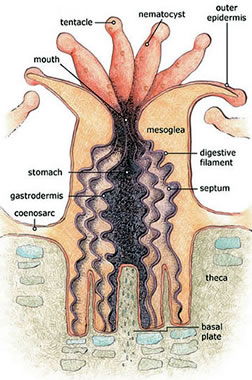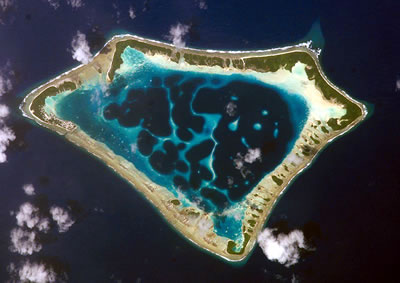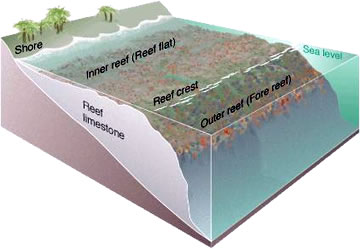Not all rocks were formed hundreds of thousands of years ago. Enormous masses of limestone are being formed today in the warmer parts of the Indian and Pacific oceans, built up particle by particle through the activities of corals.
 Corals are animals, relatives of the sea anemone that remain fixed to the same spot throughout life, feeding on organic material that drifts past in the water. They have a hard shell of calcite, formed by the extraction of calcium carbonate from seawater.
Corals are animals, relatives of the sea anemone that remain fixed to the same spot throughout life, feeding on organic material that drifts past in the water. They have a hard shell of calcite, formed by the extraction of calcium carbonate from seawater.
A coral organism, called a polyp, can reproduce by budding and the result is a branching colony of thousands of individual creatures. Each colony is usually built up on the rocky skeletons of dead polyps, and in this way the coral mass can grow and spread to form a reef.
Corals flourish only in certain conditions. They live in seawater and grow best if the water is clear and silt-free, and at a temperature of between 23 and 25°C.
Coral tissues contain single-celled plants that help them to extract the calcite from water, and the plants must have sunlight to survive - in water less than 50m deep. For these reasons, coral reefs are found in clear, shallow tropical seas.
 Reefs tend to grow in shallow offshore water, especially around islands. They cannot form near river estuaries, where the water carries suspended sand and mud.
Reefs tend to grow in shallow offshore water, especially around islands. They cannot form near river estuaries, where the water carries suspended sand and mud.
There are three main types of reefs:
1. A fringing reef forms a shelf around an island, just below water level.
2. A barrier reef lies at a distance from the island, forming a rough ring around it and separated from it by a shallow lagoon.
3. The third type of reef is the atoll, which is merely a ring of reef material with no central island at all.
The three types can be considered as three stages in a single process.
 Usually the island is volcanic, part of an island arc that rises from the sea floor where two crustal plates are converging. Once the island has appeared, corals begin to grow on its flanks, just below sea level. The outer limit of reef growth is defined by the depth (50m) below which corals cannot grow. The result is a fringing reef.
Usually the island is volcanic, part of an island arc that rises from the sea floor where two crustal plates are converging. Once the island has appeared, corals begin to grow on its flanks, just below sea level. The outer limit of reef growth is defined by the depth (50m) below which corals cannot grow. The result is a fringing reef.
As time passes the island may sink, possibly because, attached to its tectonic plate, it moves from a relatively shallow active area (such as an ocean ridge) towards deeper waters.
Alternatively the "sinking" may be due to a rise in sea level caused by the melting of polar icecaps at the end of an ice age.
As this occurs, the exposed part of the island - which is roughly conical in shape - becomes smaller. But the reef continues to build upwards from its original position. Sooner or later the island and reef become separated at the surface of the sea, producing a barrier reef. Eventually the island sinks completely, although the reef continues to grow and form the characteristic ring of an atoll.
If the atoll continues to sink and does so at such a rate that the growth of coral cannot keep ahead of it, then the coral dies and the whole reef is carried into deeper water. This may account for the existence of guyots - flat-topped underwater hills whose summits may be 2,000m below the surface of the sea. Many guyots have been found in the Pacific Ocean, and their distribution suggests that they were originally formed in the same way as the volcanic islands in the area.
Reef Structure
 A living reef forms a narrow plateau just below the surface of the water, producing an area of shallows that can be treacherous for swimmers and small craft.
A living reef forms a narrow plateau just below the surface of the water, producing an area of shallows that can be treacherous for swimmers and small craft.
Where the reef crest is above the water it forms a small flat island, often crowned with coconut palms. The island is usually covered with white sand, made from the eroded fragments of coral skeletons.
In the lagoon behind the reef there may be boulders of coral material that have been torn off the reef during storms and deposited in the calmer water.
In the sheltered water of a lagoon coral may grow into remarkable mushroom shapes and pinnacles and support a varied community of marine life.
The water in a lagoon is shallow, although not as shallow as over the reef itself. Its floor is covered by sediments of broken coral; this region is known as a flat reef.
On the seaward side of the reef its edge may be composed of the skeletons of calcite-secreting algae, because these plants are better than corals at withstanding the rougher conditions. The outer edge forms a scree slope of fragments broken from the reef.
Fossil Reefs
Geologically a reef is a mass of biogenic limestone, whose porous nature makes it a good reservoir rock for oil and natural gas.
In early times the reef organisms were very different from today's. Modern corals did not evolve until about 200 million years ago (in the Triassic period), yet the first reefs date from the Cambrian of 570 million years ago.
Many of the early reefs were built by calcite-producing algae, or by shellfish that existed on the heaps of shells left by their ancestors.